Blog categories
Blog archive
RSS Blog posts tagged with 'ideas'
Blog Filters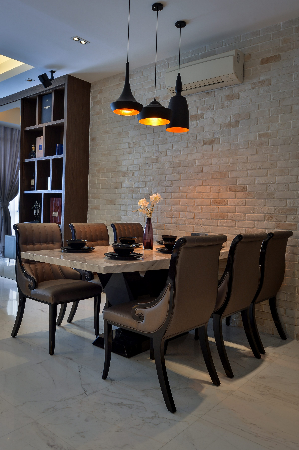
Refined Dining: 8 Dining Room Design Ideas for Small Spaces
Friday, November 20, 2020
Space is valuable, but that won't stop some of us filling out our small spaces - and we've all probably experienced regret at one point or another when over-estimating shapes and sizes. To help you plan your ideal dining setting to serve your needs without cramping your style, we gathered the best design ideas for compact dining spaces here.
1 Against the Wall Probably the first thing you would try with an existing dining set in your small space is to push the table up against a wall. You would be gaining additional space with the sacrifice of seating at one of the heads of the table, but when making do with a small area one must be willing to give up certain formalities in favour of comfortable passageways.
 A dining set in this arrangement also serves as a form of separation between spaces. Designer: Surface R
A dining set in this arrangement also serves as a form of separation between spaces. Designer: Surface R
2 Bench Seating If setting your dining table against the wall doesn't free up the kind of space you imagined, consider forgoing formality entirely by replacing some or all of your dining chairs with benches instead. Benches make for a more casual setting and do not require as much space as individual dining chairs, however some sideways shimmying and impromptu leg raises would be needed to get diners to slide in and out of position at the table.
 What this arrangement lacks in formality, it more than makes up for in the extra width of the passageway. Designer: Surface R
What this arrangement lacks in formality, it more than makes up for in the extra width of the passageway. Designer: Surface R
3 Restaurant-Style Banquette Seating Instead of setting the short edge of your dining table against the wall, conserve more space by aligning the long edge with a wall or divider and exchanging some dining chairs on the narrower side for a bench. Without the need for additional space for pulling out chairs, this arrangement occupies even less space and can be located in shared spaces such as a dry kitchen or an open layout living space to create a dining nook.
 An intimate space is formed out of a square dining table, a pair of armless dining chairs, and a customised bench occupying the corner. Designer: M Innovative Builders
An intimate space is formed out of a square dining table, a pair of armless dining chairs, and a customised bench occupying the corner. Designer: M Innovative Builders
 A variation of the dining nook is held in the centre of this open layout, with a bench formed out of a projection from the dividing wall. Designer: Jashen Interior Design
A variation of the dining nook is held in the centre of this open layout, with a bench formed out of a projection from the dividing wall. Designer: Jashen Interior Design
4 Conjoined Surfaces In our previous study of kitchen islands, we observed how joining dining tables to kitchen islands can expand your hosting capabilities, and combining them into a Teppanyaki-style setting can save space. If you have a kitchen island, consider having dining and kitchen share surfaces, or join them together to make the most of your small space.
 Combine the dry kitchen with the dining space by joining a table with your island. Designer: Nu Infinity
Combine the dry kitchen with the dining space by joining a table with your island. Designer: Nu Infinity
5 Narrow Dining Tables If central placement and more formal settings are required of your dining experience, consider selecting a narrow dining table. As we discovered in our guide on choosing dining tables, surfaces shaped as skinny rectangles are most visually appealing in long and narrow spaces.
 The use of a long and narrow surface in this dining area conserves the sense of space. Designer: Nice-Style Refurbishment
The use of a long and narrow surface in this dining area conserves the sense of space. Designer: Nice-Style Refurbishment
6 Round Dining Tables As we've pointed out before, circular dining surfaces are a more economical shape when hosting six or more diners with adequate elbow room - any less than that and a round table may seem overly large and imposing in tight quarters. If you forsee only small gatherings at dinners, stick with square tables instead - or sacrifice the extra elbow room for a small pedestal table.
 A dining surface of any other shape and hosting the same number of seats would not be aesthetically pleasing, if it is at all possible, in a tight corner such as this. Designer: Mode Interior Style
A dining surface of any other shape and hosting the same number of seats would not be aesthetically pleasing, if it is at all possible, in a tight corner such as this. Designer: Mode Interior Style
 A smaller round table is a viable solution for tight spaces, albeit with fewer seats and the sacrifice of ample elbow room. Designer: Bazarbayu
A smaller round table is a viable solution for tight spaces, albeit with fewer seats and the sacrifice of ample elbow room. Designer: Bazarbayu
7 Unifying Style The decorative approaches that seem to work best in tight quarters - minimalist designs and monochromatic or pale shades should be applied in a cohesive manner to tie distinct spaces together. Especially in open layouts, individual areas will seem less imposing with only the most sutble of distinctions existing between living and dining spaces.
 The minimalist style and monochromatic palette extends beyond the dining space, ensuring that it is subtly integrated with the rest of the home. Designer: The Roof
The minimalist style and monochromatic palette extends beyond the dining space, ensuring that it is subtly integrated with the rest of the home. Designer: The Roof
8 Transluscent Furniture Instead of falling back on designs in minimalist style, a monochromatic palette, or even pastel shades to make your dining room seem more spacious, consider seeking out transluscent furniture to pair with the reflective finishes of a modern or glam décor. The completely see-through furnishings will help to maintain an illusion of space when combined with wide windows or ample lighting.
 The presence of this dining table is obscured by its transparent form letting light pass through it, rendering the lower half almost invisible. Designer: GDY Design & Construction
The presence of this dining table is obscured by its transparent form letting light pass through it, rendering the lower half almost invisible. Designer: GDY Design & Construction
 These dining chairs are nearly imperceptible, having been formed out of clear plastic and presented under direct light. Designer: Archicentre
Read about putting together some delectable centerpiece arrangements on your dining table here.
These dining chairs are nearly imperceptible, having been formed out of clear plastic and presented under direct light. Designer: Archicentre
Read about putting together some delectable centerpiece arrangements on your dining table here.
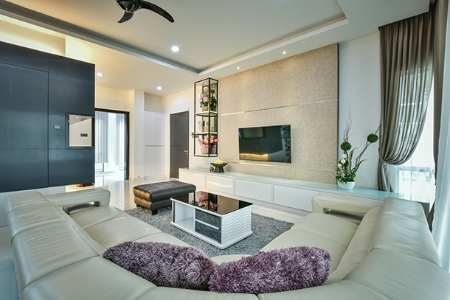
Store More: 5 Smart Storage Ideas for Your Living Room
Friday, November 20, 2020
As living rooms are among the busiest spaces in a typical family home, most of us will eventually find ourselves swamped by an assortment of unintended decorations.
Don't wait until folks come over to visit before shovelling that mess out of sight. Keep your clutter in check while prominently displaying your prized decorations by including some of these nifty storage ideas in the living room.
1. Furniture With Drawers The simplest way to add more storage space, at least without drilling any holes in the wall of your living room, is by selecting furnishings that come with drawers. A coffee table with discrete cabinet handles or a long console with ample drawers would be able to contain the clutter that typically accumulates on the coffee tables of family homes. Designer: Jashen Interior Design
Designer: Jashen Interior Design
2. Shelving Feature Wall Rather than having a purely decorative feature wall occupying usable wall space in your living room, consider incorporating shelving into the design of the wall decoration. Horizontal lines are abudant in these decorative fixtures - often used to create space-enlarging illusions; these surfaces could be easily converted into shelving with the addition of vertically oriented panels to support the weight of books.
 Designer: ID Industries
Designer: ID Industries
3. Surround the Television As we have mentioned previously, inundating your television in horizontal lines for shelving can serve to camouflage the screen against a backdrop of assorted decorations on display. The space on most walls around the television tends to be left empty in reverence to the screen, creating opportunities for shelving to be added.
 Designer: Latitude Design
Designer: Latitude Design
4. Practical Walls Let's face it, walls are boring - but before taking out walls to aim for an open layout, consider replacing non-load bearing walls with dedicated shelving instead. With shelving in place of walls you get extra storage and display space in an area that has the airiness of an open layout, but with physical forms of separation cozily enclosing the living room with clean demarcating lines.
 Designer: Beata Home and Office Furniture
Designer: Beata Home and Office Furniture
5. Alcoves in Walls If the wall you wanted to take out leads to an immediate confrontation with your neighbour - or if it is load-bearing, consider cutting an alcove out of the wall instead. Just be sure to check with engineers to ensure that your alcove is adequately large for storage but small enough that the wall retains its supportive capability. If structural considerations do not permit cutting directly into the wall, build up a false wall or a facade to the depth that would accommodate your decorations.
 Designer: Pocket Square
Designer: Pocket Square
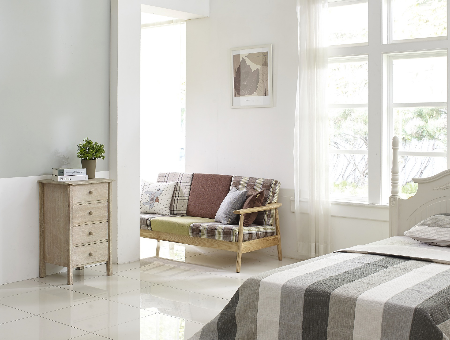
Soft and Sensual: 5 Best Window Treatments for the Bedroom
Friday, November 20, 2020
When people design a room’s décor, window treatments usually aren’t the main focus. But when it comes to bedroom décor, the type of window treatment you favour can have huge implications on how the room functions. Some people, for example, struggle to sleep when there’s too much light in their room; decorating a room to be both stylish and functional can be a challenge. With that said, there are plenty of options when it comes to window treatments and they can provide a wonderful complement to your existing décor. The key is finding what style suits you. Silk Drapes or Curtains Drapes and curtains are very similar except drapes tend to be made of a heavier material than curtains. This is one reason that drapes are used in the bedroom more than curtains – to prevent too much light from coming in. Heavier silk drapes are often used in bedrooms because they can add a touch of elegance as well as a true focal point to the room. It’s functional as well, considering the drapes can be pulled closed at night to screen out light and opened during the day. You can also dress it up even further with tassels and pull-backs. Sheers with Opaque Drapes
When you combine sheers and opaque draperies, you get the best of two worlds. Sheers are made of a translucent polyester or gauzy cotton. They can add a bit of privacy during the day and provide an ethereal atmosphere; at night, the opaque draperies in a heavy fabric can provide a heavy curtain to block light from a street lamp and to block noise from traffic.
Shades
Shades are very popular throughout the home, and they come in a wide variety of colours and styles. A shade is usually attached to a rod or frame, is made of a material that is cut to fit the window and can be lifted with a pulley. Shades are a great item to get creative with and to add a pop of personality to your room.
Blinds
Blinds are probably the most common form of window treatment. This type of window treatment is made with slats of plastic, wood, or metal that run either horizontally or vertically. They are often used in the bedroom because they are a cheap way to conveniently provide privacy while also letting sunlight through. There are some truly unique blinds available as well.
Sheers with Opaque Drapes
When you combine sheers and opaque draperies, you get the best of two worlds. Sheers are made of a translucent polyester or gauzy cotton. They can add a bit of privacy during the day and provide an ethereal atmosphere; at night, the opaque draperies in a heavy fabric can provide a heavy curtain to block light from a street lamp and to block noise from traffic.
Shades
Shades are very popular throughout the home, and they come in a wide variety of colours and styles. A shade is usually attached to a rod or frame, is made of a material that is cut to fit the window and can be lifted with a pulley. Shades are a great item to get creative with and to add a pop of personality to your room.
Blinds
Blinds are probably the most common form of window treatment. This type of window treatment is made with slats of plastic, wood, or metal that run either horizontally or vertically. They are often used in the bedroom because they are a cheap way to conveniently provide privacy while also letting sunlight through. There are some truly unique blinds available as well.
 Valances, Swags, and Cascades
If you’re the type of person who enjoys a more eclectic design, valances, swags, and cascades are a phenomenal choice. They add decorative fabric to the top of window treatments, adding an ornate personality to your dressings. Depending on the fabric you choose, they can provide much different statements to your room. They can be combined with sheers, drapes, and shades or blinds. Valances can also be made with widely varying fabrics.
There are plenty of combinations available to dress up your bedroom windows – and there truly is no “best” when personal tastes are at the forefront of the argument. With that said, these different styles of window dressings can be changed in color and fabric to suit nearly any taste you might have while also offering an easy convenience to your home.
Alex Briggs is a contributing author for Absolute Home Solutions.
Valances, Swags, and Cascades
If you’re the type of person who enjoys a more eclectic design, valances, swags, and cascades are a phenomenal choice. They add decorative fabric to the top of window treatments, adding an ornate personality to your dressings. Depending on the fabric you choose, they can provide much different statements to your room. They can be combined with sheers, drapes, and shades or blinds. Valances can also be made with widely varying fabrics.
There are plenty of combinations available to dress up your bedroom windows – and there truly is no “best” when personal tastes are at the forefront of the argument. With that said, these different styles of window dressings can be changed in color and fabric to suit nearly any taste you might have while also offering an easy convenience to your home.
Alex Briggs is a contributing author for Absolute Home Solutions.

Refined Dining: 8 Dining Room Design Ideas for Small Spaces
Friday, November 20, 2020
Space is valuable, but that won't stop some of us filling out our small spaces - and we've all probably experienced regret at one point or another when over-estimating shapes and sizes. To help you plan your ideal dining setting to serve your needs without cramping your style, we gathered the best design ideas for compact dining spaces here.
1 Against the Wall Probably the first thing you would try with an existing dining set in your small space is to push the table up against a wall. You would be gaining additional space with the sacrifice of seating at one of the heads of the table, but when making do with a small area one must be willing to give up certain formalities in favour of comfortable passageways.
 A dining set in this arrangement also serves as a form of separation between spaces. Designer: Surface R
A dining set in this arrangement also serves as a form of separation between spaces. Designer: Surface R
2 Bench Seating If setting your dining table against the wall doesn't free up the kind of space you imagined, consider forgoing formality entirely by replacing some or all of your dining chairs with benches instead. Benches make for a more casual setting and do not require as much space as individual dining chairs, however some sideways shimmying and impromptu leg raises would be needed to get diners to slide in and out of position at the table.
 What this arrangement lacks in formality, it more than makes up for in the extra width of the passageway. Designer: Surface R
What this arrangement lacks in formality, it more than makes up for in the extra width of the passageway. Designer: Surface R
3 Restaurant-Style Banquette Seating Instead of setting the short edge of your dining table against the wall, conserve more space by aligning the long edge with a wall or divider and exchanging some dining chairs on the narrower side for a bench. Without the need for additional space for pulling out chairs, this arrangement occupies even less space and can be located in shared spaces such as a dry kitchen or an open layout living space to create a dining nook.
 An intimate space is formed out of a square dining table, a pair of armless dining chairs, and a customised bench occupying the corner. Designer: M Innovative Builders
An intimate space is formed out of a square dining table, a pair of armless dining chairs, and a customised bench occupying the corner. Designer: M Innovative Builders
 A variation of the dining nook is held in the centre of this open layout, with a bench formed out of a projection from the dividing wall. Designer: Jashen Interior Design
A variation of the dining nook is held in the centre of this open layout, with a bench formed out of a projection from the dividing wall. Designer: Jashen Interior Design
4 Conjoined Surfaces In our previous study of kitchen islands, we observed how joining dining tables to kitchen islands can expand your hosting capabilities, and combining them into a Teppanyaki-style setting can save space. If you have a kitchen island, consider having dining and kitchen share surfaces, or join them together to make the most of your small space.
 Combine the dry kitchen with the dining space by joining a table with your island. Designer: Nu Infinity
Combine the dry kitchen with the dining space by joining a table with your island. Designer: Nu Infinity
5 Narrow Dining Tables If central placement and more formal settings are required of your dining experience, consider selecting a narrow dining table. As we discovered in our guide on choosing dining tables, surfaces shaped as skinny rectangles are most visually appealing in long and narrow spaces.
 The use of a long and narrow surface in this dining area conserves the sense of space. Designer: Nice-Style Refurbishment
The use of a long and narrow surface in this dining area conserves the sense of space. Designer: Nice-Style Refurbishment
6 Round Dining Tables As we've pointed out before, circular dining surfaces are a more economical shape when hosting six or more diners with adequate elbow room - any less than that and a round table may seem overly large and imposing in tight quarters. If you forsee only small gatherings at dinners, stick with square tables instead - or sacrifice the extra elbow room for a small pedestal table.
 A dining surface of any other shape and hosting the same number of seats would not be aesthetically pleasing, if it is at all possible, in a tight corner such as this. Designer: Mode Interior Style
A dining surface of any other shape and hosting the same number of seats would not be aesthetically pleasing, if it is at all possible, in a tight corner such as this. Designer: Mode Interior Style
 A smaller round table is a viable solution for tight spaces, albeit with fewer seats and the sacrifice of ample elbow room. Designer: Bazarbayu
A smaller round table is a viable solution for tight spaces, albeit with fewer seats and the sacrifice of ample elbow room. Designer: Bazarbayu
7 Unifying Style The decorative approaches that seem to work best in tight quarters - minimalist designs and monochromatic or pale shades should be applied in a cohesive manner to tie distinct spaces together. Especially in open layouts, individual areas will seem less imposing with only the most sutble of distinctions existing between living and dining spaces.
 The minimalist style and monochromatic palette extends beyond the dining space, ensuring that it is subtly integrated with the rest of the home. Designer: The Roof
The minimalist style and monochromatic palette extends beyond the dining space, ensuring that it is subtly integrated with the rest of the home. Designer: The Roof
8 Transluscent Furniture Instead of falling back on designs in minimalist style, a monochromatic palette, or even pastel shades to make your dining room seem more spacious, consider seeking out transluscent furniture to pair with the reflective finishes of a modern or glam décor. The completely see-through furnishings will help to maintain an illusion of space when combined with wide windows or ample lighting.
 The presence of this dining table is obscured by its transparent form letting light pass through it, rendering the lower half almost invisible. Designer: GDY Design & Construction
The presence of this dining table is obscured by its transparent form letting light pass through it, rendering the lower half almost invisible. Designer: GDY Design & Construction
 These dining chairs are nearly imperceptible, having been formed out of clear plastic and presented under direct light. Designer: Archicentre
Read about putting together some delectable centerpiece arrangements on your dining table here.
These dining chairs are nearly imperceptible, having been formed out of clear plastic and presented under direct light. Designer: Archicentre
Read about putting together some delectable centerpiece arrangements on your dining table here.
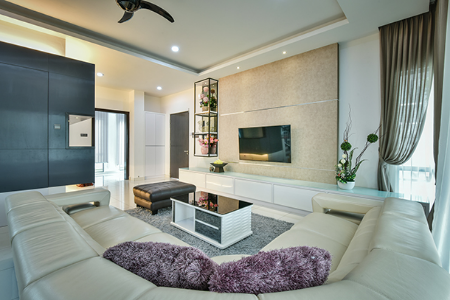
Store More: 5 Smart Storage Ideas for Your Living Room
Friday, November 20, 2020
As living rooms are among the busiest spaces in a typical family home, most of us will eventually find ourselves swamped by an assortment of unintended decorations.
Don't wait until folks come over to visit before shovelling that mess out of sight. Keep your clutter in check while prominently displaying your prized decorations by including some of these nifty storage ideas in the living room.
1. Furniture With Drawers The simplest way to add more storage space, at least without drilling any holes in the wall of your living room, is by selecting furnishings that come with drawers. A coffee table with discrete cabinet handles or a long console with ample drawers would be able to contain the clutter that typically accumulates on the coffee tables of family homes. Designer: Jashen Interior Design
Designer: Jashen Interior Design
2. Shelving Feature Wall Rather than having a purely decorative feature wall occupying usable wall space in your living room, consider incorporating shelving into the design of the wall decoration. Horizontal lines are abudant in these decorative fixtures - often used to create space-enlarging illusions; these surfaces could be easily converted into shelving with the addition of vertically oriented panels to support the weight of books.
 Designer: ID Industries
Designer: ID Industries
3. Surround the Television As we have mentioned previously, inundating your television in horizontal lines for shelving can serve to camouflage the screen against a backdrop of assorted decorations on display. The space on most walls around the television tends to be left empty in reverence to the screen, creating opportunities for shelving to be added.
 Designer: Latitude Design
Designer: Latitude Design
4. Practical Walls Let's face it, walls are boring - but before taking out walls to aim for an open layout, consider replacing non-load bearing walls with dedicated shelving instead. With shelving in place of walls you get extra storage and display space in an area that has the airiness of an open layout, but with physical forms of separation cozily enclosing the living room with clean demarcating lines.
 Designer: Beata Home and Office Furniture
Designer: Beata Home and Office Furniture
5. Alcoves in Walls If the wall you wanted to take out leads to an immediate confrontation with your neighbour - or if it is load-bearing, consider cutting an alcove out of the wall instead. Just be sure to check with engineers to ensure that your alcove is adequately large for storage but small enough that the wall retains its supportive capability. If structural considerations do not permit cutting directly into the wall, build up a false wall or a facade to the depth that would accommodate your decorations.
 Designer: Pocket Square
Designer: Pocket Square
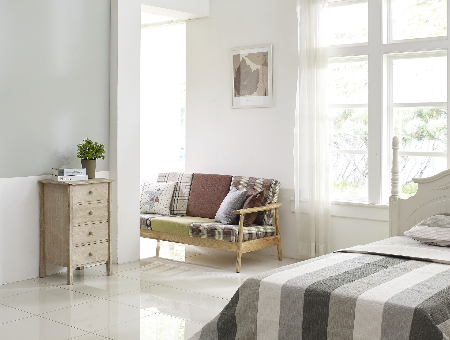
Soft and Sensual: 5 Best Window Treatments for the Bedroom
Friday, November 20, 2020
When people design a room’s décor, window treatments usually aren’t the main focus. But when it comes to bedroom décor, the type of window treatment you favour can have huge implications on how the room functions. Some people, for example, struggle to sleep when there’s too much light in their room; decorating a room to be both stylish and functional can be a challenge. With that said, there are plenty of options when it comes to window treatments and they can provide a wonderful complement to your existing décor. The key is finding what style suits you. Silk Drapes or Curtains Drapes and curtains are very similar except drapes tend to be made of a heavier material than curtains. This is one reason that drapes are used in the bedroom more than curtains – to prevent too much light from coming in. Heavier silk drapes are often used in bedrooms because they can add a touch of elegance as well as a true focal point to the room. It’s functional as well, considering the drapes can be pulled closed at night to screen out light and opened during the day. You can also dress it up even further with tassels and pull-backs. Sheers with Opaque Drapes
When you combine sheers and opaque draperies, you get the best of two worlds. Sheers are made of a translucent polyester or gauzy cotton. They can add a bit of privacy during the day and provide an ethereal atmosphere; at night, the opaque draperies in a heavy fabric can provide a heavy curtain to block light from a street lamp and to block noise from traffic.
Shades
Shades are very popular throughout the home, and they come in a wide variety of colours and styles. A shade is usually attached to a rod or frame, is made of a material that is cut to fit the window and can be lifted with a pulley. Shades are a great item to get creative with and to add a pop of personality to your room.
Blinds
Blinds are probably the most common form of window treatment. This type of window treatment is made with slats of plastic, wood, or metal that run either horizontally or vertically. They are often used in the bedroom because they are a cheap way to conveniently provide privacy while also letting sunlight through. There are some truly unique blinds available as well.
Sheers with Opaque Drapes
When you combine sheers and opaque draperies, you get the best of two worlds. Sheers are made of a translucent polyester or gauzy cotton. They can add a bit of privacy during the day and provide an ethereal atmosphere; at night, the opaque draperies in a heavy fabric can provide a heavy curtain to block light from a street lamp and to block noise from traffic.
Shades
Shades are very popular throughout the home, and they come in a wide variety of colours and styles. A shade is usually attached to a rod or frame, is made of a material that is cut to fit the window and can be lifted with a pulley. Shades are a great item to get creative with and to add a pop of personality to your room.
Blinds
Blinds are probably the most common form of window treatment. This type of window treatment is made with slats of plastic, wood, or metal that run either horizontally or vertically. They are often used in the bedroom because they are a cheap way to conveniently provide privacy while also letting sunlight through. There are some truly unique blinds available as well.
 Valances, Swags, and Cascades
If you’re the type of person who enjoys a more eclectic design, valances, swags, and cascades are a phenomenal choice. They add decorative fabric to the top of window treatments, adding an ornate personality to your dressings. Depending on the fabric you choose, they can provide much different statements to your room. They can be combined with sheers, drapes, and shades or blinds. Valances can also be made with widely varying fabrics.
There are plenty of combinations available to dress up your bedroom windows – and there truly is no “best” when personal tastes are at the forefront of the argument. With that said, these different styles of window dressings can be changed in color and fabric to suit nearly any taste you might have while also offering an easy convenience to your home.
Alex Briggs is a contributing author for Absolute Home Solutions.
Valances, Swags, and Cascades
If you’re the type of person who enjoys a more eclectic design, valances, swags, and cascades are a phenomenal choice. They add decorative fabric to the top of window treatments, adding an ornate personality to your dressings. Depending on the fabric you choose, they can provide much different statements to your room. They can be combined with sheers, drapes, and shades or blinds. Valances can also be made with widely varying fabrics.
There are plenty of combinations available to dress up your bedroom windows – and there truly is no “best” when personal tastes are at the forefront of the argument. With that said, these different styles of window dressings can be changed in color and fabric to suit nearly any taste you might have while also offering an easy convenience to your home.
Alex Briggs is a contributing author for Absolute Home Solutions.
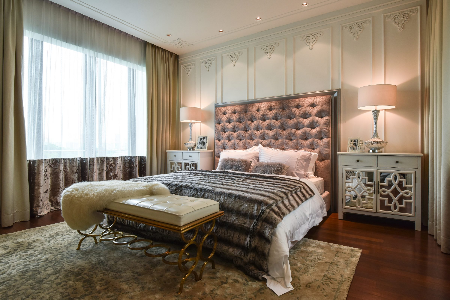
5 Bedroom Styling Ideas to Inspire You
Friday, November 20, 2020
Looking for styling ideas on how to decorate your bedroom? There are many ways to do so: you can piece together different furnishings and decorations to assemble something approaching comfort, or you could design your bedroom with an achievable end result in mind. Here are more ideas to get you inspired.
 Interior design by: SQFT Space Design Management
Interior design by: SQFT Space Design Management
1. Romantic Impressions Time-tested classical detailing in combination with peach-toned architectural finishes and decorations lend this bedroom a delicately feminine personality. The lightweight décor is complemented by rich fabrics of various shades running from the tops of walls to the floors - with cream drapery, a headboard of button-backed upholstery, and other fuzzy accompaniments rounding off the edges of the bed platform.
 Interior design by: Stylecraft Design
Interior design by: Stylecraft Design
2. Geometric Variation A simplistic interior composed of geometric designs is kept from becoming overly uniform with a variation of shapes. The wallpaper bears a vaguely Asiatic repeating motif and the decorative feature wall frames a tight cluster of mirrored hexagonal tiles subtly backlit against the horizontal wood grains. The décor is layered with various wood tones and grains to add depth and complexity to the compact space.
 Interior design by: SQFT Space Design Management
Interior design by: SQFT Space Design Management
3. Diverse Influence The dark expanse portrays a space of the masculine persuasion, while the slender metallic frames born of minimalist philosophy and bevelled mirrored panels illustrate an eclectic personality with affluent sensibilities. To bolster the opulent ambiance, the square metal pipe frames are powder coated in a shade reminescent of gold, and the varied assembly is accented with Anglophilic decorations evoking imagery of Redcoats and the English countryside complementing the plaid fabrics.
 Interior design by: SQFT Space Design Management
Interior design by: SQFT Space Design Management
4. Dainty Sanctuary When a bedroom is planned with a walk-in wardrobe space and a transparent division between bed and bath, the result is an indulgant private space that would be cause any reasonable person to pine for home. The peach and off-white palette renders a feminine vibe, complemented with classical detailing and an abundance of reflective surfaces to create an intimate and luxuriously appointed sanctuary deserving of envy.
 Interior design by: Stylecraft Design
Interior design by: Stylecraft Design
5. Refined Simplicity In this bedroom, shades and shapes are reduced to their simplest forms for an elegantly minimalist décor - the pallete is limited to a two-toned combination of eggshell white and grenish grey, in the decorative feature wall lined with fine right angles and in the glossy, reflective panels framing the sides. The selection of white bedsheets, a blanket patterned with geometry, and the inclusion of a few cut fern fronds brings the pallette to a head.
Click here for more bedrooms.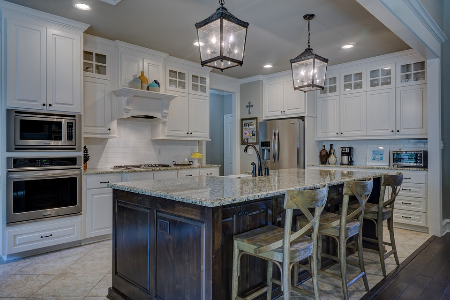
Light and Bright: 5 Kitchen Lighting Tips to Enhance Your Space
Friday, November 20, 2020
When a homeowner is busy remodeling the kitchen, often the lighting isn't considered to be a priority. However, having beautiful and efficient lighting in the kitchen not only adds to the functionality and adequate illumination, but also enhances the outstanding looks that can often be accomplished by rather simple and affordable remedies. 1. Plan Your Lighting
No one overhead ceiling-mounted fixture or recessed lighting can light the entire kitchen properly, so investigate the different types of light and the number and placement of fixtures needed for your space for the maximum benefit. For example, task lighting is most effective when it is placed below the upper cabinets with fluorescent under-cabinet lighting. Or you can install a chandelier hanging from the ceiling so that it makes it easy to read a recipe and do prep work on the work surface of an island or table.
1. Plan Your Lighting
No one overhead ceiling-mounted fixture or recessed lighting can light the entire kitchen properly, so investigate the different types of light and the number and placement of fixtures needed for your space for the maximum benefit. For example, task lighting is most effective when it is placed below the upper cabinets with fluorescent under-cabinet lighting. Or you can install a chandelier hanging from the ceiling so that it makes it easy to read a recipe and do prep work on the work surface of an island or table.
 2. Highlight Your Kitchen
Accent lighting gives depth and dimension such as adjustable fixtures inside glass-front cabinets that will illuminate precious collections, hobbies, art, china, glassware, knickknacks, and other items that will make your kitchen unique, colorful, and be a conversation piece.
2. Highlight Your Kitchen
Accent lighting gives depth and dimension such as adjustable fixtures inside glass-front cabinets that will illuminate precious collections, hobbies, art, china, glassware, knickknacks, and other items that will make your kitchen unique, colorful, and be a conversation piece.
 3. Go White
White reflects light and bounces it back into the room, making the space feel brighter and well-illuminated while allowing a lower wattage of bulbs and a conservation of energy. So consider white for the walls, ceiling, cabinets, and countertops to maximize the light. A kitchen having dark surfaces requires one-third more light than a kitchen with lighter surfaces.
3. Go White
White reflects light and bounces it back into the room, making the space feel brighter and well-illuminated while allowing a lower wattage of bulbs and a conservation of energy. So consider white for the walls, ceiling, cabinets, and countertops to maximize the light. A kitchen having dark surfaces requires one-third more light than a kitchen with lighter surfaces.
 4. Use Pendant Lamps
Pendant lights not only give a lot of direct task lighting, but they also allow for a variety of sizes, shapes, colors, styles, and decorative features to add to the looks of your kitchen.
4. Use Pendant Lamps
Pendant lights not only give a lot of direct task lighting, but they also allow for a variety of sizes, shapes, colors, styles, and decorative features to add to the looks of your kitchen.
 5. Install Dimmers
Have dimmers on the various lights so that you can have bright light when you are cooking and doing chores, but then be able to dim the lights to linger over a meal or dessert or create warmth and ambience.
Article courtesy of Patriot LED
5. Install Dimmers
Have dimmers on the various lights so that you can have bright light when you are cooking and doing chores, but then be able to dim the lights to linger over a meal or dessert or create warmth and ambience.
Article courtesy of Patriot LED

Alfresco Furnishing: How to Choose Outdoor Furniture
Friday, November 20, 2020
If you're in the midst of designing your outdoor spaces - or if you've just come across our ideas on what to do with your urban garden space, and now find yourself wondering how to go about furnishing your outdoor sanctuary, then this is the guide for you. To help you find the right furniture, we studied a selection of outdoor spaces around the country and arrived at the following list of pointers to keep in mind when looking for your garden furniture.
Function As with any other space, consider the intended purpose of a space before setting out on your search for furniture. Whether your aim is to create a solitary seating lounge or an additional area for communal dining, the function of your outdoor space will help you to determine the kind of furnishings required. Also look to whether your outdoor space is dedicated or shared: a dedicated seating lounge will be able to host furnishings of greater weight and size, while a shared space containing both dining and seating areas may require discrete furnishings that can be moved or stacked in storage as needed.
Size Is your outdoor space wide or compact? A narrow outdoor space would not typically benefit from the placement of furnishings with hefty frames, often making for cramped quarters that contradict the expanse of the outdoors. A more balanced composition could be achieved in narrow outdoor spaces using furniture of sleek designs, with robust furnishings being more suited to wide and uninterrupted spaces.
 Image Credit: Les Asia
Image Credit: Les Asia
As we mentioned previously in our guide on selecting dining tables, there are rules-of-thumb that decorators use to achieve comfortable arrangements of furniture within a defined space. These guidelines suggest that the space typically required between dining furniture and walls would be around 900cm and 1.3 meters, while each seat should be afforded around 60cm to 70cm of space on both sides for adequate elbow room. This same guideline would be applicable for outdoor spaces surrounded by lush greenery, with greater distances afforded if the outdoor space comes with uninterrupted views.
 Interior design by: Zids Design
Interior design by: Zids Design
Material The consideration of the kind of material that your outdoor furniture should be composed of: wood, stone, metal, or plastic, is largely dependant on the style you want to affect, but it would be vital to keep in mind that the material choice will have an effect on the visual weight and longevity of your furniture.
 Interior design by: Sky Creation
Interior design by: Sky Creation
Outdoor furnishings composed of stone or wood are ideal for arrangements paying homage to traditional styles, but they tend to be bulkier in design, requiring more space as a result so as not to appear overly imposing. As we found with kitchen countertops: stone and wood materials are naturally porous, requiring specialised treatment and dedicated maintenance with sealing waxes or oils to keep their lustre.
 Interior design by: Latitude Design
Interior design by: Latitude Design
A greater variety of styles may be achieved with outdoor furnishings constructed out of metal or plastic due to their relatively higher strength - even in designs with narrow profiles. With the clear exception of wrought iron furniture, the tendency apparent in metal or plastic furnishings is a lean toward modern and minimalist designs, making metal and plastic furniture ideal for smaller outdoor spaces or for complementing contemporary interiors.
Click here to see some delectable outdoor arrangements.
Urban Oases: 5 Outdoor Garden Ideas for Urban Homes
Friday, November 20, 2020
The possibilities that come with large gardens are limitless: you could put in a pond for fish, a pool for yourself, a water feature to sit by, wooden decking for large gatherings, a farm so that you never have to go grocery shopping ever again, and a meandering rock path or flowing brook surrounded by lush foliage for a meditative sanctuary. But for most of us living in the city, our options are limited by the space between the substructures of our homes and the edges of our property lines, so we peeked into some yards to list the following ideas for decorating your small garden spaces.
1) PlantersIf you're living in a high-rise structure, your outdoor garden options are probably limited to the balcony. But don't let that dishearten you, as these deceptively narrow spaces can be transformed into lush gardens with the addition of some pots, bowls, boxes, and improvised planters adorning the railings, floor, or walls. If your balcony does not receive much sunlight, consider planting some shade-loving varieties.
 This balcony goes a step further towards an immersive garden space with the use of artificial grass carpeting on the floor. Designer: X-Two Concept
2) Hardscaping
This balcony goes a step further towards an immersive garden space with the use of artificial grass carpeting on the floor. Designer: X-Two Concept
2) Hardscaping
Perhaps gardening is just not your forté and you would prefer to devote your garden to additional space for hosting gatherings instead - implementing wood decking or some other form of hardscape provides a functional platform while reducing some of the landscaping concerns. With a hardscape deck as the centrepiece of an outdoor space, plants become more of an optional adornment that can be replaced by furniture, lighting, or other forms of decoration.
 The wooden deck of this home leaves a fringe of grass around the edges for a striking contrast between the green and the wood tones. Designer: IDS Interior
3) Rock Garden
The wooden deck of this home leaves a fringe of grass around the edges for a striking contrast between the green and the wood tones. Designer: IDS Interior
3) Rock Garden
While hardscaping makes for functional spaces, the act of replacing garden space with architectural finishes does not allow much room for creative expression. For those seeking to unleash their inner artist, we highly recommend the meditative exercise of creating a Zen space in a garden of any size, using your own curated selection of fine or coarse sand, gravel, pebbles, and larger stones. Restrict the shape and size of your rock garden with wood and moss-covered stones - or let it flow freely, then plant herbs or other small plants and maybe even some decorative sculptures among the stones to complete the arrangement.
 Image credit: ScapeXpert
4) Water Feature
Image credit: ScapeXpert
4) Water Feature
A significant component of a home with favourable “Feng Shui” - the water feature is almost always expected of both residential and commercial properties in Asia. It is generally a positive thing to have a water feature facing a window or doorway into the home, more so with some varieties of Asian carp (鲤鱼; pinyin: Li Yu) living in it and Chinese Evergreen (萬年青; pinyin: Wan Nian Qing) or other plants around it.
 What would have been an insignificant side yard is turned into a meditative corner complete with the sounds of falling water. Designer: Homlux Interior Furnishing
5) Furniture
What would have been an insignificant side yard is turned into a meditative corner complete with the sounds of falling water. Designer: Homlux Interior Furnishing
5) Furniture
Any avid gardener will tell you that the best way to enjoy the result of your yard work is with a lawn chair and a cool drink in hand. Placing seating and table surfaces in and around your garden makes for a pleasant change from indoor seating rooms, that and it serves as an excuse to show off your garden. Select ready-made lounge furniture with frames made of natural materials such as wood and stone, or engineered materials such as carbon-coated steel, wrought iron, and UV-cured plastic to better endure the elements, or even construct your own out of reclaimed materials for a bespoke arrangement.
 As this outdoor lounge has the benefit of a roof, the ratan weave furnishings will last significantly longer. Designer: Space Living
Figure you have the space for a pool? Read our guide on pool design considerations here.
As this outdoor lounge has the benefit of a roof, the ratan weave furnishings will last significantly longer. Designer: Space Living
Figure you have the space for a pool? Read our guide on pool design considerations here.





